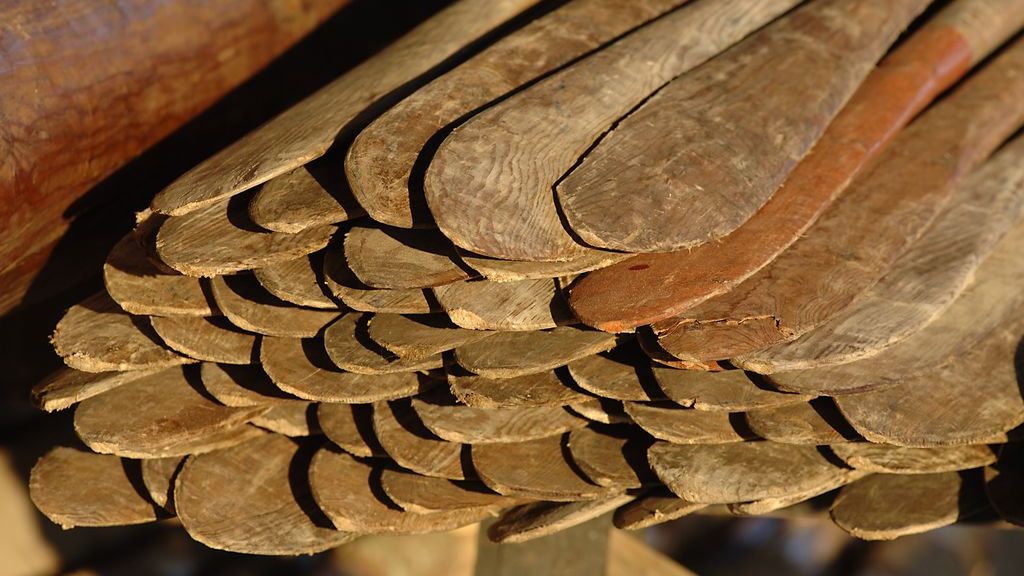The heavy, rhythmic drone of the crash of the mallets against the wedges that slowly work their way deeper into the impressive 180 year old oak tree, is like a 1,000 year old pulse being brought back to life. The excitement mounts in concert with the sounds from the strong oak, which reluctantly yields to the boatbuilders’ well-aimed strikes.
Monday the 15th June at 10am, the Viking Ship Museum's boatbuilders will begin cleaving a 7m long oak trunk, with a diameter of 1m: an oak of this size is roughly 180 years old. This summer, the Viking Ship Museum's boatbuilders are working on the reconstruction of the Gislinge Boat - a small working boat from the 12th century - and the large oak is going to provide the material for the boat's planks.
"The Gislinge Boat Project is about reconstructing the boat as closely to the original as possible, while also building with contemporary tools and using the same methods and techniques as boatbuilders in the past" tells boatbuilder Martin Dael. "Therefore, we also use the ancient technique of cleaving in order to produce the boat's planks from the large oak" he continues.
Axes, not saws
In the Viking and early Middle Ages, the saw was not used when boatbuilding. Planks were cleaved using axes, mallets and wedges - and raw muscle power! The great oak is split along the length of the tree's fibres, first in half, then quarters, then eighths and then sixteenths. In oak trees, the pith rays extend from the pith in the centre to the outer edge of the tree, like spokes on a bicycle wheel.
When planks are cleaved and not sawn, it is important that the tree has the right size and is of the right quality. A tree must be straight-growing and knot-free, and it must be big: in order for a tree to provide a plank with a finished width of 25-30cm, the tree must have a diameter of around 1m.
For boatbuilding, a straight-growing tree is always preferable, as the cleaving - and therefore the planks - will curve if the tree is curved. It's also easier to get a greater number of planks of equal thickness when the tree is straight-growing. A curved plank is still just as strong, however, so long as the boatbuilder follows the line of the curve and doesn't cut across the fibres.
After cleaving, the pieces are roughly shaped using an axe before being finished with a broad axe, the long edge of which can smoothen the surface of the plank. A plank is called a board once it is finished and set in position on the boat
Early medieval boat reconstruction at the boatyard: info
The Gislinge Boat is a 7.7m long working boat from the Middle Ages, which was found during excavation near Gislinge in 1993, a reclaimed part of the Lammefjord. The construction project is being carried out at the Viking Ship Museum's boatyard, with as much involvement from the public as possible. Many activities have been planned in conjunction with the build, so that visitors to the Museum can experience all the aspects of the boatbuilding project. Open source boatbuilding At the same time, the Museum will make all details about the construction freely available online, where the working drawings for the boat are also available for download. On the website, we discuss the choice of materials, construction process and interpretation of the original find. We call it open source boatbuilding and it's also possible for others to try their hand at building their own version of the Gislinge Boat. You can also follow the project on Facebook and Instagram, where we share film, photos and other nerdy details. The construction will take ca. 6 months and we expect to launch the boat during the autumn holiday. The boatyard is open every day from 10:00 - 17:00 (10:00 - 16:00 from the 24th August onwards).Activities at the boatyard: every weekend in June and 7 days a week from 27th June - 23rd August The project is supported by Kraks Fonden. Click on the links below to follow the project:
» Instagram @vikingshipmuseum
» Facebook...






